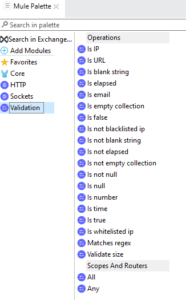Introduction:
Mulesoft has provided a bunch of validation components which is very useful for message field validation during developments. These validations can be general or based on specific requirements. Validators are used to verify that parts of the Mule message/events to meet some kind of criteria which we specify.
If a message doesn’t meet the validation criteria, validation component generates Validation error. Here, we can customize the exception message that is displayed in logs/responses.
Let’s see some of important and frequently used validation components
 |
| mule4-validation-module |
Is not null:
This components checks if the field value should be not null or else throws’ error with “Name is Mandatory field“
<validation:is-not-null value="#[payload.name]" message="Name is Mandatory field"/>
Is email:
This components checks if the incoming email field is in valid format or not else throws validation error with message “Invalid Email format“.
<validation:is-email email="#[payload.email]" message="Invalid Email format"/>
ALL vs ANY
To perform multiple validation at a time in mule flow. Mulesoft provides two scopes ALL and ANY which is used for these purpose.
ALL:- All validation should be passed from a set validation components defined in ALL scope.
<validation:all>
<validation:is-not-null value="#[payload.name]" message="Name is Mandatory field"/>
<validation:validate-size value="#[payload.name]" min="5" max="20" message="Name field size should be between 5 and 20"/>
</validation:all>
Here we are checking name field should not empty and name length should be minimum length 5 and max 20. It is similar to AND conditions like any programming language.
ANY:- Any of the validation components should be passed from a set of Validation components defined in ANY scope
<validation:any>
<validation:is-not-null value="#[payload.name]" message="Name is Mandatory field"/>
<validation:validate-size value="#[payload.name]" min="5" max="20" message="Name field size should be between 5 and 20"/>
<validation:any>
With Any scope we are ensuring any of the above condition should pass, it will pass the the validation. It is similar to OR conditions like any programming language.
Based on project requirement we can used these scopes with multiple validation components at a time.
Use of validation module Dataweave:
Now let us see how we can use these mule validation components can be used as Mule expression to make decisions without throwing any validation errors.
<choice>
<when expression="#[ Validation::is-not-null(payload.name) and Validation::is-not-null(payload.name)]">
<set-payload value='#[payload.name ++ " is a valid name."]'/>
</when>
<otherwise>
<set-payload value='#[payload.name ++ " is NOT a valid name."]'/>
</otherwise>
</choice>
Happy learning 🙂

Your place is valueble for me. Thanks!?